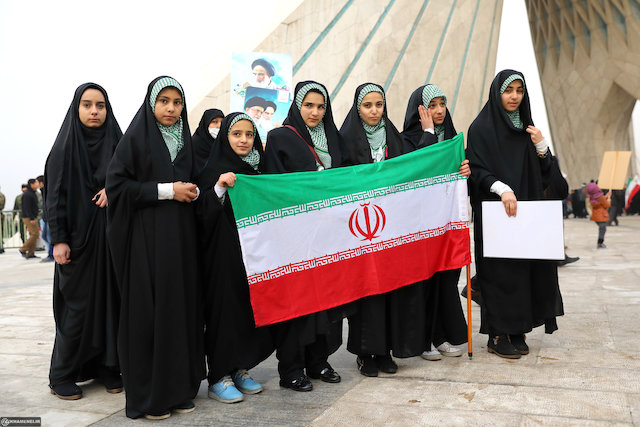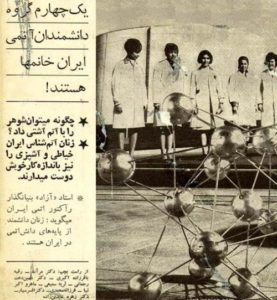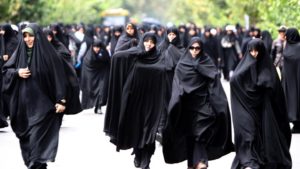Women’s Day Special: Women and the Iranian Revolution: A Historical Perspective
Rinita MazumdarWomen’s movement in Iran cannot be understood without tying it to people’s nationalist, democratic, and anti-imperialist struggles
Photo: Courtesy Khamenei.ir

“Iran” as a nation was formed in 1910 (it was carved out of the remnants of the older colonial “Persia” and the remnants of Persia and the Ottoman Empire. The British, as in all cases of colonialism constructed two “nations” “Iran” and “Iraq” and put their surrogate (sounds familiar?) rule the Shah of the Pallavi dynasty. During 19760s, the then Shah wanted to “modernism” Iran (his idea was to make Iran more European than Europe), and he wanted to industrialize at a very fast pace. So he needed Western help, and what did he give in return? The wealth, that the west wanted. He sold all the oil mills to the Western Company. The British (BP) so far had monopoly; now, however, it was Chevron and so on who wanted a monopoly of the oil fields.
Iran was a feudal and semi feudal agricultural country and due to this uneven process of development it was still in the 17th/18th century. In order to change Iran overnight to the 20th and 21st century, the Shah had to make some drastic changes. With the help of his Western allies he tried to modernize Iran and the only way it could be done is if Iran could sell its petroleum products to the West in return for Iran to get technical help and make necessary reforms faster.
The entire economy was devoted to exporting one commodity, petroleum, and no diversification was done. Traditionally Persians had a rich heritage of producing many different commodities, such as rugs, world famous carpets, jewelry, baskets. These were mostly done by bazar merchants who suffered from the Shah’s economic policies. Further, all kinds of small traders, petty bourgeois, shopkeepers, and Islamic doctors suffered under this new policy.
Only 20% of the top class became “modern”, extremely wealthy and very Westernized. They were supported by Shah’s corrupt regime and controlled all the wealth and power in Iran. They were so to speak, “more European than European”. First, there were contradictions between the upper class elites and the smaller lower to lower middle (also working class and peasants) on the economic level, as the latter gained nothing from Shah’s modernization policy. Second, there were contradictions on the level of identity.

Courtesy of the Franklin D. Roosevelt Library & Museum via Wikimedia Commons
“Iran” was constructed along the identity of the new extremely Westernized men and women who formed the upper 20% of Iran. The lower class, lower middle class, and rural population, specially women who followed traditional dress code and were not “modernized”, were ridiculed as “backward”, “lower class” “not real Iranians”. The women of this class suffered both economic deprivation and exclusion from the “modern upwardly mobile new Iran”. This slowly led to a huge frustration amongst people in this class. Iran did have progressive movements like the Communist Party and the Feminist movement, but they could not give leadership to the aspirations and frustrations of the common people, as these ideologies were seen as “Western”.
The Iranian Revolution and Women
Initially the “revolution” of 1979 was people’s movement against Shah’s imperialism, elitism, and corruption. Women joined in large numbers in this movement. In 1979 many stepped out from the private sphere into the public arena, they disseminated information, distributed leaflets, gave shelter to political activists under attack, and many actively demonstrated and marched in the streets and made barricades against the police. Many were part of the guerilla movement and went underground. What was originally a movement against imperialism and corruption, nevertheless, turned into something quite different.
As the left, democratic, and progressive movements failed to give a voice to the movement, it was co-opted by Ayatollah Ruhollah Khomeini, the father of the Iranian revolution and founder of the Islamic Republic of Iran. Khomeini and the Islamic fundamentalist gave voice to the thousands of men and women who were excluded and humiliated in the process of nation building in Iran.

Courtesy: Not Even Past
Khomeini constructed a new concept of “Iran” as opposed to the “West”; he also reinterpreted and reconstructed “Islam” as an indigenous nationalism that is a voice against “Western Imperialism”. The Shah, in order to modernize Iran, made many changes in the laws that affected women, such as the Family Protection Law, where polygamy was restricted, women’s age of marriage was raised, and mothers had custody of children. The Shah, however, had failed to implement the land reforms and the peasants did not gain much from his economic policies.
Khomeini’s regime repealed the Family Protection Law in 1979 and the laws were mostly copied from the Shariyat Laws. Thus, women had to veil, their access to education and employment were restricted and became limited, and the age of marriage was reduced to thirteen. Women could not seek divorce under this new Shariyat law.
Many women who were enthusiastic about the revolution slowly realized that it was moving in the wrong directions, and many stopped supporting it, many joined guerrilla forces and went underground.
Contradiction In The System About Women
Some women gained a positive self-concept, and a sense of power, dignity, and pride from the revolution. But the “Islam” that was constructed to oppose the Shah cannot be called “indigenous”; it was a reaction to the historical crisis that previous colonization, uneven development of capitalism, class struggle, and lack of progressive leadership played.

The re-building of Iran went through much contradictions, as most of its resources were spent in war as Saddam Hussein, backed by most western nations such as France, UK, USA, as he was seen as the strongest force in the middle east to counter “Islamic fundamentalism” waged war during the next decade.
Women’s movements in Iran and the “middle east” thus cannot be understood without tying it to people’s nationalist, democratic and anti-imperialist struggles. In addition, the women’s movement is closely and intricately linked to class struggles in these nations and has to be read as part of the larger democratic movements.
(The author teaches Philosophy and Culture Studies at Central New Mexico Community College and is an affiliate Prof of Women Studies at the University of New Mexico)